
You are using an out of date browser. It may not display this or other websites correctly.
You should upgrade or use an alternative browser.
You should upgrade or use an alternative browser.
The Phoenix Down Experiment
- Thread starter Firebird211
- Start date
Firebird211
Hero Member
- Messages
- 734
richship said:I think you can attach .mp3's directly to posts now using +Additional Options. The mediafire thing started throwing windows around and didn't look work-safe.
Thanks, I will have to try that, mediafire has been a pain in my arse with all of their ads. Your not missing much, yet. :laughing7: Son of a biscuit, both mp3's are too big. I will keep in mind for future samples to keep things short and sweet. Clips still are not uploading, but I added vintage rails 30sec in series, then 30 sec in parallel with a parallel setting lead. I'm sure you will be able to hear when the switch is flipped, and the rhythm took on a much more suitable tone in parallel mode. I think I will just put them in Sonar and just whack them down to a reasonable size. The dist.mp3 sample is bridge/neck then towards the end just the bridge.
Attachments
Firebird211
Hero Member
- Messages
- 734
richship said:That worked. Nice to put a voice to the guitar.
That is such a gorgeous and versatile guitar. I remember looking at binding options and not being able to think what the pearloid would look good on. Damn nice!
Thanks man, I know can I make better clips if I practice much much more. This guitar will not limit me, and I adore her voice. I was performing last saturday, and I though, damn this feels good.:guitaristgif: Strats are just terrible terrible guitars. :icon_jokercolor:
I had a heavy personal debate over the neck and body binding when I was making the decisions. At that point the builder didn't show what it would look like, but I figured I just have to give it a shot to set it off. It really deserves better pics.
Firebird211
Hero Member
- Messages
- 734
I have reached a few conclusions after having even more quality time with the guitar. I am not completely satisfied with the functionality of the tone switch and the cap types and values associated with it. With the previous build I found putting a 0.022uf Polyester in parallel with a 0.022uF Mallory, which would be a total of 0.044uF, was a nice value giving me a nice depth of range without getting muddy. It seems as if the 0.022uF PIO has the potential for some mud at full setting and even deeper mud when the mylar black beauty is put in parallel to it giving a total capacitance of 0.042uF. The three way switch has the potential to switch three different cap values independently if I decide to change my mind, and currently it is either bypassing tone, using the 0.022uF PIO, or adding the 0.02uF cap in parallel. The bypass really isn't usefull as I originally hoped, the full volume and tone settings of the guitar are comparibly as wide open as that setting is. The guitar is already bright, so the capability of adding the piezo with the magnetic pickups is also less useful than I originally hoped. I am not sure if the wood type of the guitar changed the dynamics of sound that much because most every pickup is exactly the same when using even less capacitance as before. :icon_scratch: With further experimentation I am contemplating making the tone switch change cap values 0.01uF, 0.022uF, and 0.033uF, and using different types as well. I am even thinking about the possibility of using a black ice overdrive( or homemade diode set) as one of the three settings.(I think not) I am going to tinker with some of these things and when it's time to replace the strings again...it's on.
Firebird211
Hero Member
- Messages
- 734
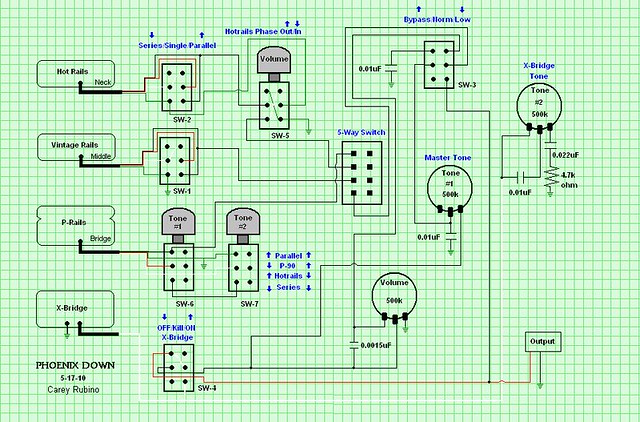
The fatal flaw with the previous design I was trying to get rid of was the fact that in order to use the bypass setting, the kill switch had to be set as well, which causes the piezo and the magnetic to play together with no load. It's kind of cool, but so loud and bright you can't dicern the two, so it's basically pointless. The piezo just seems to be more useful on its own. I am changing the circuit, so it can toggle three different cap values 0.01uF(paper/wax), 0.022uF(mylar), and 0.032uF(mylar in parallel with paper/oil). So much for "I'm not going to update the circuit", but this will be more useful, and make more sense to an unsuspecting person that picks the guitar up. The bypass feature will still be in the tone circuit, but will be a pot modification instead, so it will be quick and easy to set whenever the mood calls.
I am embarassed to say I don't know what I was thinking when I thought the piezo and the magnetic are in the circuit at the same time in bypass mode. In the original circuit that was not how I designed it, and that hasn't changed...it is still seperate. I designed it that way, so you couldn't have them both on at the same time, while allowing a bypass. The bypass sounds a lot like the piezo where it can cut glass. The high impedance output of the piezo looks like a capacitance to the other circuit. The piezo and magnetic are on together at the same time while the piezo is on and the bypass mode on the tone circuit is on. I have been without the thing for too long when I first designed it, and that was the feature that made it so weird and confusing. :toothy11:Now that I remember how it works I can better evaluate the changes I want to make if any. :doh: If I forget how that part of the circuit works, then it must not be very intuitive, and I believe I can find a better way to do it.
Working with everything further, I would of liked to add an additional capacitor for the option, but the circuit was set up the way it was for a reason, to cover for the capabitlity of mixing the piezo and magnetic, while still allowing for a full bypass. The kill switch was an additional compromise to allow that setting to happen, while allowing everything to be shut-off or just the cool effect of the killswitch. After weighing the options I feel it would be better to just swap the caps to smaller values, since that is where my discontent is. The piezo/magnetic is awesome and gives a full doubling effect, almost as if the guitar is mimicking a 12 string. The grease bucket circuit still works in that setting, and I can't just ditch that. I blame my forgetfulness on mood-dependant memory. The bypass modification directly to the tone pot would of caused popping and cheesy operation. When the two bottom switches are pulled toward me, you get the combination mag/piezo. The bypass is combined with the killswitch, so it has to be deliberately set. If I think of a better way without adding another switch...I doubt it. I will just play the damn guitar instead.
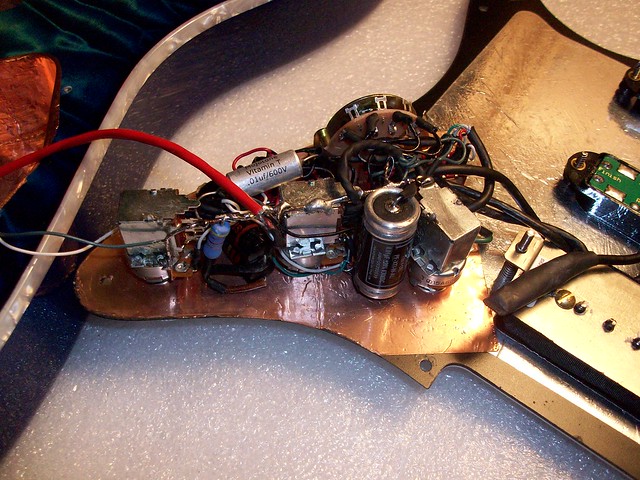
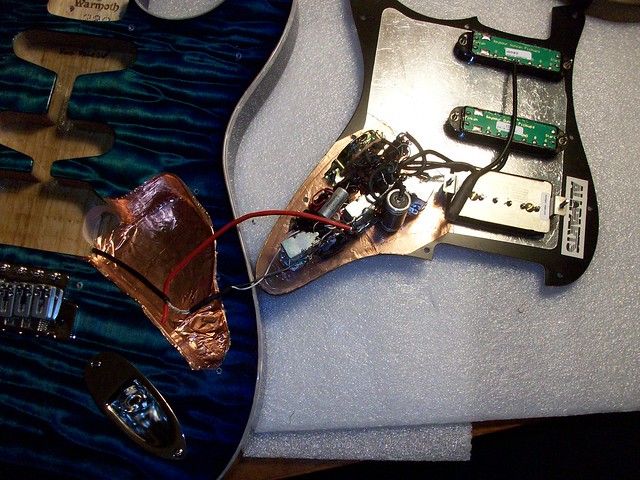
The Ampohm wax/paper was quite larger than I expected(looks like a freaking battery), but found a solid place to put it where it fits. The Mojotone paper/oil was much smaller, luckily. The Ampohm is a stand alone in the 0.01uF position and the two are in parallel in the 0.02uF position. The tone control is much more usable now.
Just what we need...more pictures of the same guitar.
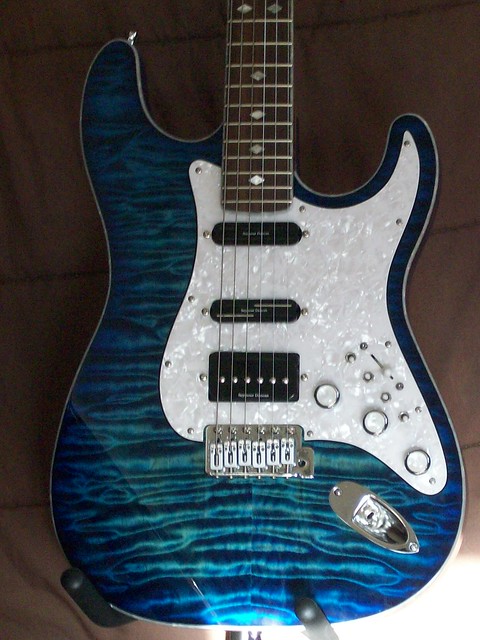
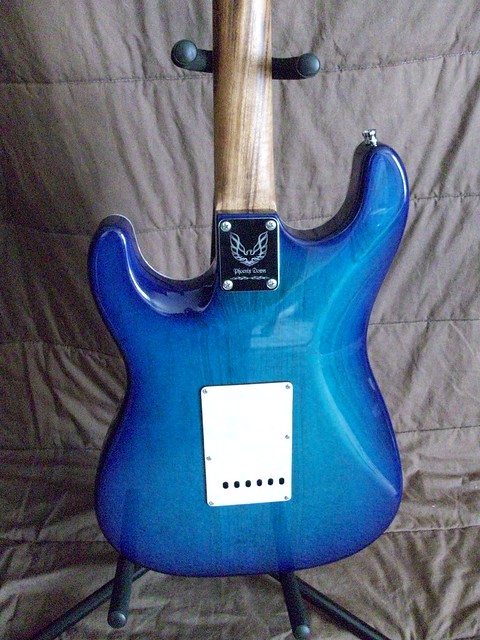
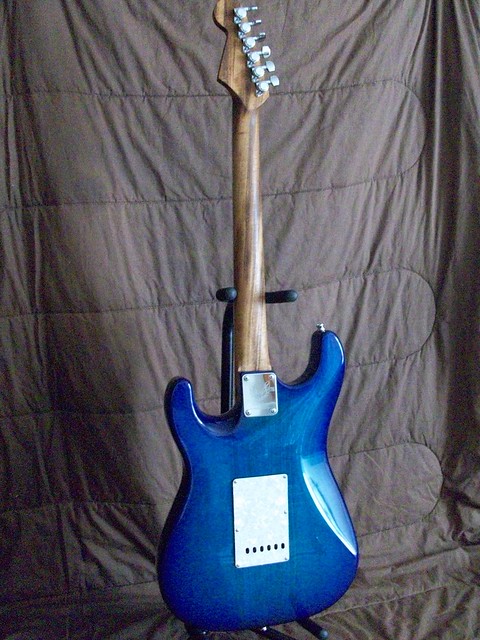
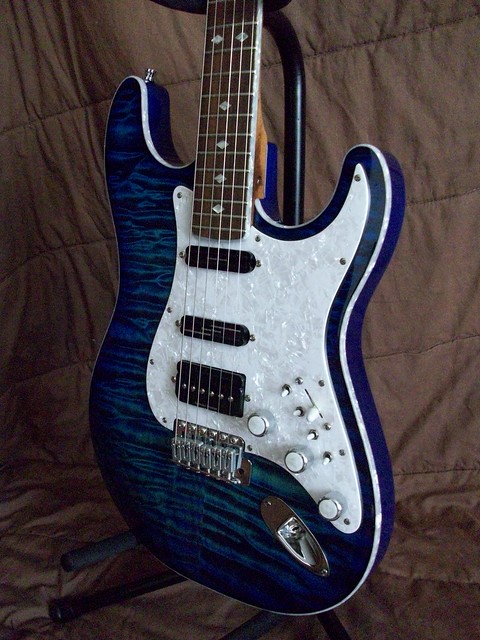
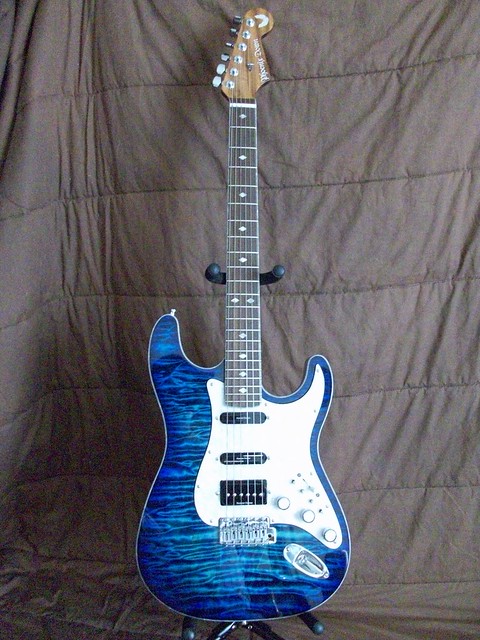
Firebird211
Hero Member
- Messages
- 734
Here you go per Dustycat, I recorded short clips of the Piezo with just the P90 and the Piezo while switching between the neck,middle, and bridge. The P90 one just has the P90 bridge first, so you can hear the difference when the Piezo kicks in.
Attachments
Firebird211
Hero Member
- Messages
- 734
Thank You Dustycat, and that was just standard picking. No double finger picking at all, eventhough it sounds like it at times while playing back the 2nd mp3.
line6man
Epic Member
- Messages
- 6,443
BlueFirebird said:I am changing the circuit, so it can toggle three different cap values 0.01uF(paper/wax), 0.022uF(mylar), and 0.032uF(mylar in parallel with paper/oil).
That's 0.023uF, not 0.032uF. (Plus or minus variations in tolerance.)
I really cannot imagine that the shift in the cutoff frequency would be all that noticeable/useful between 0.022uF and 0.023uF
Also, what is the deal with these ridiculous paper in oil caps? You're wasting space when a film cap of the same actual capacitance would do the same thing.
The very high wattage resistor is a good choice, however. The larger physical area makes for less contact noise, if there is any difference at all. :blob7:
Firebird211
Hero Member
- Messages
- 734
line6man said:BlueFirebird said:I am changing the circuit, so it can toggle three different cap values 0.01uF(paper/wax), 0.022uF(mylar), and 0.032uF(mylar in parallel with paper/oil).
That's 0.023uF, not 0.032uF. (Plus or minus variations in tolerance.)
I really cannot imagine that the shift in the cutoff frequency would be all that noticeable/useful between 0.022uF and 0.023uF
Also, what is the deal with these ridiculous paper in oil caps? You're wasting space when a film cap of the same actual capacitance would do the same thing.
The very high wattage resistor is a good choice, however. The larger physical area makes for less contact noise, if there is any difference at all. :blob7:
0.010uF + 0.022uF = 0.032uF :icon_scratch:, Its probably easy to accidently misplace the decimal point if I don't place the zero after 0.01uF. Either way, I wound up using one 0.01uF, and adding another 0.01uF to give 0.02uF in parallel. This, in turn, has given two slightly different, but usefull tone tapers given what the voice of the guitar is with the pickups and the body together. With just a different body, it was a different story, and the larger cap values worked better in that scenario, even with the same pickups.
line6man
Epic Member
- Messages
- 6,443
BlueFirebird said:line6man said:BlueFirebird said:I am changing the circuit, so it can toggle three different cap values 0.01uF(paper/wax), 0.022uF(mylar), and 0.032uF(mylar in parallel with paper/oil).
That's 0.023uF, not 0.032uF. (Plus or minus variations in tolerance.)
I really cannot imagine that the shift in the cutoff frequency would be all that noticeable/useful between 0.022uF and 0.023uF
Also, what is the deal with these ridiculous paper in oil caps? You're wasting space when a film cap of the same actual capacitance would do the same thing.
The very high wattage resistor is a good choice, however. The larger physical area makes for less contact noise, if there is any difference at all. :blob7:
0.010uF + 0.022uF = 0.032uF :icon_scratch:, Its probably easy to accidently misplace the decimal point if I don't place the zero after 0.01uF. Either way, I wound up using one 0.01uF, and adding another 0.01uF to give 0.02uF in parallel. This, in turn, has given two slightly different, but usefull tone tapers given what the voice of the guitar is with the pickups and the body together. With just a different body, it was a different story, and the larger cap values worked better in that scenario.
Nevermind, I wasn't paying attention. :blob7:
Cagey
Mythical Status
- Messages
- 24,425
Well, Mr. Bluefirebird (if that's your real name...), you have inadvertently stepped on yet another of my pet peeves in the guitar world: the bizarre and inexplicably persistent myth that capacitor construction types influence tone or character. Tsk, tsk. It is to laugh. Silliest thing I've ever heard. Or, not heard, as the case may be.
Do you know why they make capacitors out of mylar, aluminum oxide, paper over oil, polystyrene, ceramic, electrolytic fluid, unobtanium, air, etc., etc. and change their leads from solid core wire to surface mount to axial vs. radial? The answer is very simple: to change their working voltage, the range of capacitance the package is available in, and/or the mechanical/package properties of the device. That's it, and that's all. End of discussion.
At audio frequencies, changing from an $18 .01uf paper over oil in an axial package with a 600WVDC rating to a $.50 cent .01uf ceramic disc with a 50WVDC rating will have no effect on the circuit, as long as the circuit never exceeds 50 volts, and they're both actually .01uf. This isn't an opinion, it's a fact. I don't care what the cork-sniffers on The Gear Page say. They're not engineers, or if they are, they're misguided, or they're pure musicians, or some combination of all three.
You just have to keep in mind that the power of suggestion is tremendous. If you pay $18 for a cap, it's gonna sound better to you. Almost guaranteed, unless you know better.
The short story is: .01uf is .01uf, regardless of the physical characteristics of the device. If anyone hears a difference between two .01uf caps of different construction, it's because they're not both .01uf caps. They're just marked as such. There's a manufacturing tolerance to the things which is often astounding in its variance.
Capacitors do their "tone" thing by presenting a lower impedance to certain frequencies. Which frequencies are affected depends entirely on capacitive reactance, which is set by the capacity of the component. That can be changed by adding other circuitry around them, but that doesn't change the cap itself. A perfect example is the dead-simple tone circuit in most guitars. The reactance can be changed by adding DC resistance via potentiometer to the circuit. That doesn't change the cap, though. It just changes how fast it charges and discharges, which sets its reactance. Increase the DC resistance high enough, and the total impedance is such that little or nothing gets pulled to ground. Reduce it, and a lot gets pulled down. Depending on the size of the cap and the frequencies it's presented with will set what gets "filtered" out.
That's just a thumbnail, but it's enough. While it's certainly true that construction/packaging will affect how a cap performs, generally speaking, you need to be up in a frequency range well outside of even magic vampire bat hearing for it to be an issue. I mean, radio and microwave frequencies. Then, you can start talking about the inductance and DC resistance differences between radial and axial packages, lead length, solder and lead attachment metallurgy, dielectrics, etc. The guys who design cell phones, microwave towers, satellites, radars, etc. have to worry about this stuff; guitar players don't.
So, long story short, get all that space-hogging stuff out of there. You'll be glad you did.
Do you know why they make capacitors out of mylar, aluminum oxide, paper over oil, polystyrene, ceramic, electrolytic fluid, unobtanium, air, etc., etc. and change their leads from solid core wire to surface mount to axial vs. radial? The answer is very simple: to change their working voltage, the range of capacitance the package is available in, and/or the mechanical/package properties of the device. That's it, and that's all. End of discussion.
At audio frequencies, changing from an $18 .01uf paper over oil in an axial package with a 600WVDC rating to a $.50 cent .01uf ceramic disc with a 50WVDC rating will have no effect on the circuit, as long as the circuit never exceeds 50 volts, and they're both actually .01uf. This isn't an opinion, it's a fact. I don't care what the cork-sniffers on The Gear Page say. They're not engineers, or if they are, they're misguided, or they're pure musicians, or some combination of all three.
You just have to keep in mind that the power of suggestion is tremendous. If you pay $18 for a cap, it's gonna sound better to you. Almost guaranteed, unless you know better.
The short story is: .01uf is .01uf, regardless of the physical characteristics of the device. If anyone hears a difference between two .01uf caps of different construction, it's because they're not both .01uf caps. They're just marked as such. There's a manufacturing tolerance to the things which is often astounding in its variance.
Capacitors do their "tone" thing by presenting a lower impedance to certain frequencies. Which frequencies are affected depends entirely on capacitive reactance, which is set by the capacity of the component. That can be changed by adding other circuitry around them, but that doesn't change the cap itself. A perfect example is the dead-simple tone circuit in most guitars. The reactance can be changed by adding DC resistance via potentiometer to the circuit. That doesn't change the cap, though. It just changes how fast it charges and discharges, which sets its reactance. Increase the DC resistance high enough, and the total impedance is such that little or nothing gets pulled to ground. Reduce it, and a lot gets pulled down. Depending on the size of the cap and the frequencies it's presented with will set what gets "filtered" out.
That's just a thumbnail, but it's enough. While it's certainly true that construction/packaging will affect how a cap performs, generally speaking, you need to be up in a frequency range well outside of even magic vampire bat hearing for it to be an issue. I mean, radio and microwave frequencies. Then, you can start talking about the inductance and DC resistance differences between radial and axial packages, lead length, solder and lead attachment metallurgy, dielectrics, etc. The guys who design cell phones, microwave towers, satellites, radars, etc. have to worry about this stuff; guitar players don't.
So, long story short, get all that space-hogging stuff out of there. You'll be glad you did.
Firebird211
Hero Member
- Messages
- 734
Cagey said:Well, Mr. Bluefirebird (if that's your real name...), you have inadvertently stepped on yet another of my pet peeves in the guitar world: the bizarre and inexplicably persistent myth that capacitor construction types influence tone or character. Tsk, tsk. It is to laugh. Silliest thing I've ever heard. Or, not heard, as the case may be.
Do you know why they make capacitors out of mylar, aluminum oxide, paper over oil, polystyrene, ceramic, electrolytic fluid, unobtanium, air, etc., etc. and change their leads from solid core wire to surface mount to axial vs. radial? The answer is very simple: to change their working voltage, the range of capacitance the package is available in, and/or the mechanical/package properties of the device. That's it, and that's all. End of discussion.
At audio frequencies, changing from an $18 .01uf paper over oil in an axial package with a 600WVDC rating to a $.50 cent .01uf ceramic disc with a 50WVDC rating will have no effect on the circuit, as long as the circuit never exceeds 50 volts, and they're both actually .01uf. This isn't an opinion, it's a fact. I don't care what the cork-sniffers on The Gear Page say. They're not engineers, or if they are, they're misguided, or they're pure musicians, or some combination of all three.
You just have to keep in mind that the power of suggestion is tremendous. If you pay $18 for a cap, it's gonna sound better to you. Almost guaranteed, unless you know better.
The short story is: .01uf is .01uf, regardless of the physical characteristics of the device. If anyone hears a difference between two .01uf caps of different construction, it's because they're not both .01uf caps. They're just marked as such. There's a manufacturing tolerance to the things which is often astounding in its variance.
Capacitors do their "tone" thing by presenting a lower impedance to certain frequencies. Which frequencies are affected depends entirely on capacitive reactance, which is set by the capacity of the component. That can be changed by adding other circuitry around them, but that doesn't change the cap itself. A perfect example is the dead-simple tone circuit in most guitars. The reactance can be changed by adding DC resistance via potentiometer to the circuit. That doesn't change the cap, though. It just changes how fast it charges and discharges, which sets its reactance. Increase the DC resistance high enough, and the total impedance is such that little or nothing gets pulled to ground. Reduce it, and a lot gets pulled down. Depending on the size of the cap and the frequencies it's presented with will set what gets "filtered" out.
That's just a thumbnail, but it's enough. While it's certainly true that construction/packaging will affect how a cap performs, generally speaking, you need to be up in a frequency range well outside of even magic vampire bat hearing for it to be an issue. I mean, radio and microwave frequencies. Then, you can start talking about the inductance and DC resistance differences between radial and axial packages, lead length, solder and lead attachment metallurgy, dielectrics, etc. The guys who design cell phones, microwave towers, satellites, radars, etc. have to worry about this stuff; guitar players don't.
So, long story short, get all that space-hogging stuff out of there. You'll be glad you did.
Good Lord, you guys are just now figuring this out. This guitar has been a done deal for quite some time now, and there are no space problems, or reasons to take the guitar apart to make anyone happy, but myself. In a completely custom guitar can I not build it like I want? I actually have an Electrical Engineering Degree, and am employed as an Engineer. I am quite aware of everything that you just said. I have seen the arguments for and against “the difference” too many times on the Internet. The parties involved are usually people who were willing to try and experiment, and those that “know” that don’t want to try anything different. If there was a difference the tone circuit of a guitar is not going to be the best place to hear it because it can only take away, and not pass through like a coupling capacitor, like in amplifiers, and other audio circuits. Even then, I don’t care to humor an argument that is endless and pointless for your satisfaction
Cagey
Mythical Status
- Messages
- 24,425
I'm sorry; I just assumed that anyone who would install capacitors like that didn't have a good understanding of how they work or what the specs mean. I, too, am cursed with a EE degree and several decades of experience, so I try to pass along corrections to baseless urban legends when they show up in the hope that they'll save somebody some trouble.
So... just out of curiosity, why did you install those things? Just happened to have them in the parts drawer?
So... just out of curiosity, why did you install those things? Just happened to have them in the parts drawer?
DustyCat
Hero Member
- Messages
- 853
BlueFirebird said:Thank You Dustycat, and that was just standard picking. No double finger picking at all, eventhough it sounds like it at times while playing back the 2nd mp3.
You are welcome Mr. BlueFireBird, and thank you for posting these sound clips,
The Impressive design of your "Phoenix Down Experiment" Guitar fills me with the desire to pursue a Bird of my own (in this case Guitar). May I humbly offer LED's that light up (maybe not on the knobs?) during switch activation like on an HUD?
The clips are solid, and the fidelity demonstrates the sounds of the pickup combinations one might expect to hear when changing from one to the next. Good call sticking with a clean tone. :icon_thumright:
I for one, would like to hear more of this guitar.
Perhaps you could ignite the afterburners for us in the next batch? :guitaristgif: :rock-on:
-DC
P.S. What the heck is "Double Finger Picking?"
Firebird211
Hero Member
- Messages
- 734
Cagey said:I'm sorry; I just assumed that anyone who would install capacitors like that didn't have a good understanding of how they work or what the specs mean. I, too, am cursed with a EE degree and several decades of experience, so I try to pass along corrections to baseless urban legends when they show up in the hope that they'll save somebody some trouble.
So... just out of curiosity, why did you install those things? Just happened to have them in the parts drawer?
Well, after I researched the subject and all of the arguments some time ago, which included listening to that guy with all of the different capacitors on Youtube, I decided I was curious enough to get quite a few different caps with the same values to see for myself. Trying to prove it right or wrong is like arguing about religion, since there are no facts that would be considered tangible by what we know by our standards. My first experience with this was taking out ceramic caps and putting polyester ones in their place, on my first guitar. Maybe I have dog ears, but I thought the ceramic added harsh overtones, and the polyester had a smoother quality about them, given the same tonal range. I have a capacitance meter built into my DVM, and there was no significant difference due to tolerance on those or the caps that I am using now. Phoenix Down seemed to be slinging a bunch of mud with very little tone control use, that was when I decided it was time to step the caps down, and lower values would mean that I would get the cap more involved by the means of turning the tone pot down more to get tone change. Luckily I put that true bypass feature in the guitar, and I premade a 1/4" cable to a 250k pot, and start trying all of the wierd caps I had. I messed with many different values and types in that external control circuit. I basically turned the pot all the way down for the primary comparison, and just used the pot to make a sample sweep of the taper. Given what ever little differences in tolerance that were not showing up on my meter, I would have to assume I wouldn't be able to hear that difference either. The little bugger and the big bugger of the same 0.01uF value kind of blew my mind when I compared it to a mylar and other caps of the same value. The gigantic paper in wax(Ampohm) had an airy or sparkly quality, and what sounded like a warm tight bass response. The little paper in oil(Mojo) was quite a bit punchier and aggressive while still covering a similar tone range. Together in parallel, they sound like a dynamic duo of both qualities, keeping in mind clean settings were used and some light overdrive. The Ampohm was a problem child due to it's size, and I had plenty of thought and opportunity to just say eff it and put in some other smaller cap. From what I was hearing in the comparison, that was how bad I wanted to get it in, and make it the primary 0.01uF setting.
As far as my background, I also spent two years in highschool in an electronics program before I ever got into college, so I can think like an electron, and it is a curse sometimes when my understanding of something exceeds my ability to explain it. Even freakyer I have seen in Physics and Fluid Dynamics some of the same rules apply as they do in electronics. Proving or disproving would be impossible as the only way other than hearing it, which will differ from person to person, guitar equipment, etc, would be to take a snapshot on a spectrum analyser or even an oscilloscope and overlap the results. You would see a difference in waveform with the same capacitor just from hitting the strings, since all of the little mechanical differences in how the string is hit come into play, and all the mechanical vibrations. I have read so many times where engineers and non-engineers are just ripping into somebody claiming bs, voodoo, unicorns, gremlins when I am not so sure they even tried it themselves, so why bitch about it? I think anybody should stick to the norms that work because there are a bunch of capacitors that sound the same, and the average one sounds just fine. I just wanted a guitar that can jump start a car.
Firebird211
Hero Member
- Messages
- 734
DustyCat said:BlueFirebird said:Thank You Dustycat, and that was just standard picking. No double finger picking at all, eventhough it sounds like it at times while playing back the 2nd mp3.
You are welcome Mr. BlueFireBird, and thank you for posting these sound clips,
The Impressive design of your "Phoenix Down Experiment" Guitar fills me with the desire to pursue a Bird of my own (in this case Guitar). May I humbly offer LED's that light up (maybe not on the knobs?) during switch activation like on an HUD?
The clips are solid, and the fidelity demonstrates the sounds of the pickup combinations one might expect to hear when changing from one to the next. Good call sticking with a clean tone. :icon_thumright:
I for one, would like to hear more of this guitar.
Perhaps you could ignite the afterburners for us in the next batch? :guitaristgif: :rock-on:
-DC
P.S. What the heck is "Double Finger Picking?"
Double Finger Picking would be when you are plucking two strings at the same time with your fingers instead of picking. You could harmonize two strings or use the next octave up to accentuate the note. It was just when I listened to it I thought I better tell him that or he will think that it was just the style of picking I was using. There are harder soundclips floating around this thread, but I would like to make more as I get better at playing, and recording. The sound setting was Fender Cybertwin's "Good Ol Boys" lol. Thanks for the words of encouragement. :rock-on:
DustyCat
Hero Member
- Messages
- 853
Double Finger Picking would be when you are plucking two strings at the same time with your fingers instead of picking. You could harmonize two strings or use the next octave up to accentuate the note. It was just when I listened to it I thought I better tell him that or he will think that it was just the style of picking I was using. There are harder soundclips floating around this thread, but I would like to make more as I get better at playing, and recording. The sound setting was Fender Cybertwin's "Good Ol Boys" lol. Thanks for the words of encouragement. :rock-on:
[/quote]
No problem, and thanks for the enlightening. I've heard of double stop but I've never heard of double finger picking...strange. Anyways, here's a cool clip I found about double stops, but not double fingerpicking...
http://m.youtube.com/index?desktop_uri=%2F&gl=US#/watch?v=QOhmmRLGkuk
It's insteresting that "Double Stop" do not not specify picking technique which means you could use a pick or fingers. (I wonder if it is the "f" hole on this guitar that gives it the richess/sparkle/burnt quality
More clips please! Also, it doesn't have to be fancy or evn original. Just some chords etc. :rock-on:
[/quote]
No problem, and thanks for the enlightening. I've heard of double stop but I've never heard of double finger picking...strange. Anyways, here's a cool clip I found about double stops, but not double fingerpicking...
http://m.youtube.com/index?desktop_uri=%2F&gl=US#/watch?v=QOhmmRLGkuk
It's insteresting that "Double Stop" do not not specify picking technique which means you could use a pick or fingers. (I wonder if it is the "f" hole on this guitar that gives it the richess/sparkle/burnt quality
More clips please! Also, it doesn't have to be fancy or evn original. Just some chords etc. :rock-on:
Firebird211
Hero Member
- Messages
- 734
Will do Dustycat, I usually just pick up the guitar and go on a rant anyway, so no big deal.
Similar threads
- Replies
- 3
- Views
- 485
- Replies
- 6
- Views
- 240

